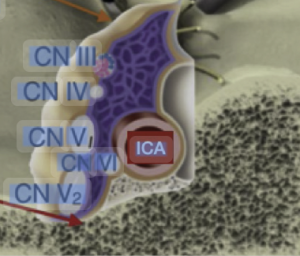In a anatomic-imaging correlation study with a single-case MR + dissection design Mark el al. 1) from the Department of Radiology, Mayo Clinic, Rochester, Minnesota, USA, Department of Neurosurgery, University of Valencia and Fundación Instituto Valenciano de Oncología (IVO), Valencia, Spain publiseh in the American Journal of Neuroradiology (AJNR) to determine whether high-resolution T2-weighted MRI can visualize the parasellar ligaments, which have previously only been described in cadaveric dissection or intraoperative findings, and to correlate these MRI findings with anatomical dissection in the same specimen. The authors report that parasellar ligaments can be identified on high-resolution T2-weighted MRI as T2-hypointense, bandlike structures originating from the medial wall of the cavernous sinus. They claim that identifying these ligaments may be relevant, given that resection of the medial wall of the cavernous sinus has been associated with better outcomes in functioning pituitary adenoma surgery.
This study is a prime example of technological overreach dressed up as discovery. It takes a single cadaver, applies ultra-high-resolution MRI, and then retrofits a minor fibrous band into a clinical “finding.” The result is a beautifully imaged, clinically irrelevant piece of anatomical embroidery that contributes nothing actionable to radiology, neurosurgery, or pituitary surgery.
❌ Critical Flaws
1. Sample Size = 1
This is not a study. It’s an anatomical anecdote with MRI. No reproducibility, no variability, no statistical value. It offers the illusion of science without the burden of method.
2. Speculative Clinical Relevance
The authors loosely associate the imaging of parasellar ligaments with surgical outcomes in pituitary adenoma, despite zero clinical data, no patient cohort, and no intraoperative validation. This is an exercise in wishful correlation masquerading as translational science.
3. Overinterpretation of Imaging
The so-called T2–hypointense “bandlike structures” are interpreted as parasellar ligaments with no histologic proof, no differentiation from adjacent fibrous tissues, and no comparison across multiple specimens or live imaging. Could it be artifact, fascia, or vessel wall? The authors don’t bother to ask.
4. Redundancy with Existing Literature
The parasellar ligaments have already been described in surgical anatomy. Rewrapping them with MRI adds no functional knowledge, only visual novelty. This is not innovation—it’s anatomical redecoration.
5. Journal Standards Questioned
That AJNR accepted and published this article suggests a troubling editorial laxity: prioritizing image quality over clinical impact, and novelty over substance.
📉 Conclusion
What we have here is a single-case, ultra-specialized, low-evidence paper pretending to offer a new radiological frontier. In reality, it is an aesthetic showcase with no clinical consequence, no reproducibility, and no justification for its conclusions. It stands as a case study in radiological self-indulgence—an MRI mirage of significance
